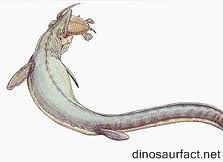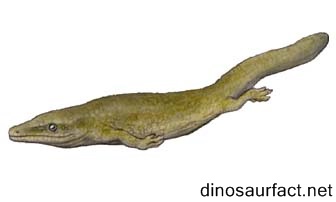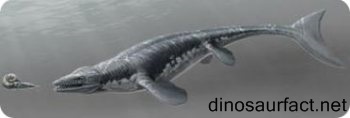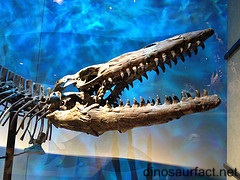 Click to visit the previous Marine Specie bio
Click to visit the previous Marine Specie bio
 |
|
 |
|
Kingdom: Animalia
Phylum: Chordata
Class: Sauropsida
Order: Squamata
Family: Mosasauridae
Genus: Dallasaurus
 |
|
 |
|
 |
|

Dallasaurus pronounced Dall-oh-sore-us, is the Greek word standing for the ‘Lizard of Dallas’. Fossil records suggest that these animals inhabited the oceans of North America approximately during the mid cretaceous period believed to be anything around ninety million years ago. Fossil records suggest Dallasaurus were around three feet in length and weighed around twenty five pounds.
It has been a comical tragedy that by the standards of general public, a reptile named after the state of Dallas is expected to be big, something land bound, and something that could have probably resembled a buffalo. But to the disappointment Dallasaurus was a rather sleek and small animal that was probably semi aquatic in habitat. Rather fossil studies indicate that it very much resembled a seal. A very common irony has been observed in the discovery of dinosaur fossils. Especially when it is about dinosaurs belonging to the Mesozoic era, aquatic fossils are found in plenty when compared to the ones that were considered to be land bound. The mid west and west America was actually covered with shallow seas during the cretaceous period.
- Dallasaurus has a great evolutionary importance as it is considered to be the most basal Mosasaur. Dallasaurus is considered to be the most distant ancestor to the fierce and sleek marine reptiles that were predators of the ocean. They were believed to be preying on the fish and other marine fauna.
- Fossil study suggests that Dallasaurus possessed movable flippers resembling limbs. This indicated that this animal possessed a semi aquatic life style. Dallasaurus was thus considered to be among the earliest tetrapods.
The discovery of Dallasaurus is quite fascinating for the lovers of marine reptiles as they swam the oceans during the Mesozoic era. Skeletal features observed in the Dallasaurus exhibited remarkable evidence to make it believe that Mosasaurs evolved from the terrestrial lizards. However there also has been a counter theory that Mosasaurs have evolved from primitive snakes. However the later concept was gradually dismissed with the new discoveries of early Mosasaurs along with different cretaceous snakes. The scientific diagnoses of the fossils suggested otherwise. Rather it should be worth mentioning that though marine reptiles including ichthyosaurus, Pliosaurus and plesiosaurus have been proven to have evolved from terrestrial reptiles belonging to the diapsid clan but the evolution of Mosasaurs have been found to be belonging to a completely different lineage.
Dallasaurus has been considered to be having an important transitional link as they have proven to be evolved from terrestrial to aquatic origin. Fossil studies show that the body and tail of Dallasaurus have shown adaptation for swimming. Again the hind legs have a better adaptation for walking. This bodily characteristics suggest that Dallasaurus were probably inhabiting coastal areas or in the estuarine waters. It was of an advantage to them as they had plenty of aquatic animals to prey on whereas after eating they could also have easily returned to the land. It is believed that in land they would have possibly taken rest or would have to prey for other animals in different waters in the coastal area. Scientists presume that this kind of roaming behavior had a role to play in the oceanic expansion. This helped the Dallasaurus to have preyed on a greater number of prey. Fossil studies reveal that later in the Mosasaurs, these legs would have probably evolved into flippers. This would have aided the later Mosasaurs to lead a completely aquatic lifestyle.
- However till date scientists are unable to confirm whether Dallasaurus was oviparous or viviparous in nature. Some schools still believe that both the processes were still missing. Fossil studies indicate that the later Mosasaurs were too large to return to land to conceive. But again evolution suggests that the reptiles were very quick to adapt to the physiology of live birth. Fossil studies of Ichthyosaurus have revealed this. The example of Keichousaurus can also be mentioned regarding this context. Live birth is as a phenomenon that is still observed in some lizards today. Sea snakes have been reported to be conceiving by live birth.
Scientists and evolutionary experts believe that reptiles like Dallasaurus and Russellosaurus could have evolved into fifteen meters long Tylosaurus or the more evolved Platycarpus which was possessing a tail fluke like the ones present in Ichthyosaurus. They could also have evolved into Globidens. These creatures were having special teeth having crushing ability to feed on armored preys.
Dallasaurus fossil was discovered by Dr Van Turner in Dallas. However it took him quite a long time to unearth the mystery behind this Mosasaur. Basically these fossils were accidentally discovered at a construction site. Dallasaurus was believed to inhabit approximately at such a time when it is proven that most of the present landmass of Dallas was underwater. Dallasaurus was the first studied fossil that was studied in depth. This studies gave an insight into the area where scientists have been forced to believe that there were pre historic animals that could have survived both in land as well as water.
Michael Polcyn has been a frontline researcher of Dallasaurus. His research has provided a major breakthrough on Dallasaurus. His research has brought out various information on habitat, weather condition of Dallasaurus. Researchers have been more interested in Dallasaurus as they have provided to be a missing link between prehistoric reptiles and their evolved descendants.
Scientists have been a firm believer of the possibility that there must have been a certain level of harmony and an unsolved power equation between the terrestrial and the aquatic dinosaurs.
Dallasaurus have been believed to be extinct approximately around the same time when the other terrestrial dinosaurs got extinct. Dallasaurus were believed to be the masters and rulers of the marine world.
On a concluding note it should be mentioned that the discovery of Dallasaurus fossils is still now believed to be one of a kind. Till date there has been a workforce of a number of paleontologists and archaeologists who are still researching on the Dallasaurus. In fact Dallasaurus research is still a very much open subject for research and something that has been attracting a lot of attention.
Index
Extinct Profiles
 Triassic Dinosaurs
Triassic Dinosaurs Jurassic Dinosaurs
Jurassic Dinosaurs Cretaceous Dinosaurs
Cretaceous Dinosaurs Pterosaurs
Pterosaurs Marine Reptiles
Marine Reptiles Dinosaur Extinction
Dinosaur Extinction